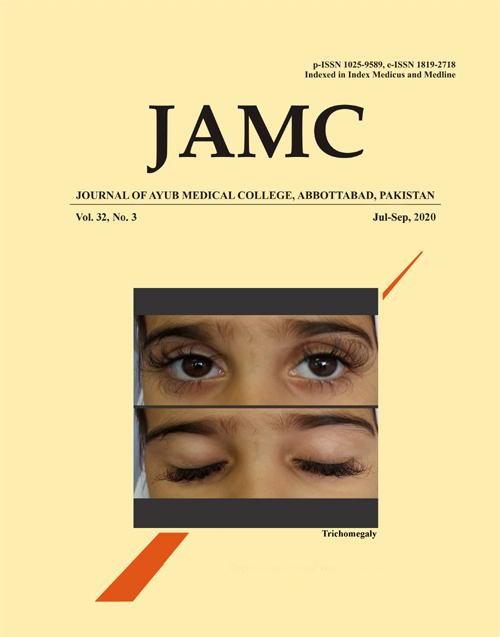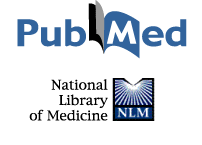BACTERIOLOGICAL PROFILE AND ANTIBIOTIC SUSCEPTIBILITY PATTERNS IN DIABETIC FOOT INFECTIONS, AT LADY READING HOSPITAL, PESHAWAR
Abstract
Background: Diabetic foot ulcer is one of the common complications of diabetes and is also the major cause of hospitalization across the world. To treat it properly, bacteriological profile is important to institute appropriate treatment. This study is done with the objective to determine the microbiological profile and antibiotic susceptibility patterns of organisms isolated from diabetic foot ulcers in Lady Reading Hospital, Peshawar Pakistan. Methods: This cross-sectional study was conducted from January to June 2019. Swab samples were collected from 114 patients with diabetic foot infections and inoculated on appropriate media. Antibiotic susceptibility tests were done by Kirby Bauer disk diffusion method. Results: E. coli were predominately isolated in the study, with ESBL in 41.6% of the cases. Strains of Pseudomonas with MDR and XDR were isolated in 21.8% and 6.25% of the patients respectively. Majority of Gram-positive isolates were Staphylococcus aureus, those were MRSA in 76.6% of samples. The commonly involved sites of DFU were the toes and forefoot, and the main causes were blister formation or trauma. Most of the patients were identified to have risk factors such as peripheral neuropathy, peripheral arterial disease, over weight and poorly controlled diabetes. Conclusion: In our study, Gram negative aerobes were predominantly isolated in the diabetic foot infections. A significant number of MDR isolates were also observed. Lack of awareness about DFU and inappropriate use of broad-spectrum antibiotics may be the main cause of increase in the frequency of MDR isolates.
Keywords: Diabetic foot ulcer; Diabetic foot infections; Antibiotic susceptibilityReferences
Alavi A, Sibbald RG, Mayer D, Goodman L, Botros M, Armstrong DG, et al. Diabetic foot ulcers: part I. Pathophysiology and prevention. J Am Acad Dermatol 2014;70(1):e1-1.
Jalilian M, Sarbarzeh PA, Oubari S. Factors Related to Severity of Diabetic Foot Ulcer: A Systematic Review. Diabetes Metab Syndr Obes Targets Ther 2020;13:1835-42.
Zhang P, Lu J, Jing Y, Tang S, Zhu D, Bi Y. Global epidemiology of diabetic foot ulceration: a systematic review and meta-analysis. Ann Med 2017;49(2):106-16.
Yazdanpanah L, Nasiri M, Adarvishi S. Literature review on the management of diabetic foot ulcer. World J Diabetes 2015;6(1):37.
Miyan Z, Fawad A, Sabir R, Basit A. Microbiological pattern of diabetic foot infections at a tertiary care center in a developing country. J Pak Med Assoc 2017;67(5):665-9.
Bakker K, Apelqvist J, Lipsky BA, Van Netten JJ. The 2015 IWGDF guidance documents on prevention and management of foot problems in diabetes: development of an evidence-based global consensus. Diabetes Metab Res Rev 2016;32(Suppl 1):2-6.
Amjad SS, Zafar J, Shams N. Bacteriology of diabetic foot in tertiary care hospital; frequency, antibiotic susceptibility and risk factors. J Ayub Med Coll Abbottabad 2017;29(2):234-40.
Blanes JI, Merino R, Lozano F, del Castillo JG, Barberán J, Zaragoza R, et al. Consensus document on treatment of infections in diabetic foot. Rev Esp Quimioter 2011;24(4):233-62.
Gadepalli R, Dhawan B, Sreenivas V, Kapil A, Ammini AC, Chaudhry R. A clinico-microbiological study of diabetic foot ulcers in an Indian tertiary care hospital. Diabetes Care 2006;29(8):1727-32.
Bozkurt F. Comparison of microbiological results of deep tissue biopsy and superficial swab in diabetic foot infections. J Microbiol Infect Dis 2011;1(3):122-7.
Jeffcoate WJ, Vileikyte L, Boyko EJ, Armstrong DG, Boulton AJ. Current challenges and opportunities in the prevention and management of diabetic foot ulcers. Diabetes Care 2018;41(4):645-52.
Ibrahim A. IDF Clinical Practice Recommendation on the Diabetic Foot: A guide for healthcare professionals. Diabetes Res Clin Pract 2017;127:285-7.
Nather A, Cao S, Chen JL, Low AY. Prevention of diabetic foot complications. Singapore Med J 2018;59(6):291-4.
Prompers L, Huijberts M, Apelqvist J, Jude E, Piaggesi A, Bakker K, et al. High prevalence of ischaemia, infection and serious comorbidity in patients with diabetic foot disease in Europe. Baseline results from the Eurodiale study. Diabetologia 2007;50(1):18-25.
Sekhar S, Vyas N, Unnikrishnan M, Rodrigues G, Mukhopadhyay C. Antimicrobial susceptibility pattern in diabetic foot ulcer: a pilot study. Ann Med Health Sci Res 2014;4(5):742-5.
Akhi MT, Ghotaslou R, Asgharzadeh M, Varshochi M, Pirzadeh T, Memar MY, et al. Bacterial etiology and antibiotic susceptibility pattern of diabetic foot infections in Tabriz, Iran. GMS Hyg Infect Control 2015;10:Doc02.
Ramakant P, Verma A, Misra R, Prasad K, Chand G, Mishra A, et al. Changing microbiological profile of pathogenic bacteria in diabetic foot infections: time for a rethink on which empirical therapy to choose? Diabetologia 2010;54(1):58-64.
Tiwari S, Pratyush DD, Dwivedi A, Gupta SK, Rai M, Singh SK. Microbiological and clinical characteristics of diabetic foot infections in northern India. J Infect Dev Ctries 2012;6(4):329-32.
Anvarinejad M, Pouladfar G, Japoni A, Bolandparvaz S, Satiary Z Abbasi P, et al. Isolation and Antibiotic Susceptibility of the Microorganisms Isolated from Diabetic Foot Infections in Nemazee Hospital, Southern Iran. J Pathog 2015;2015:328796.
Ali SM, Basit A, Shaikh T, Mumtaz S, Hydrie MZ. Diabetic foot ulcer-a prospective study. J Pak Med Assoc 2001;51(2):78-81.
Banashankari GS, Rudresh HK, Harsha AH. Prevalence of Gram Negative Bacteria in Diabetic Foot -A Clinico-Microbiological Study. Al Ameen J Med Sci 2012;5(3):224-32.
Ahmadishooli A, Davoodian P, Shoja S, Ahmadishooli B, Dadvand H, Hamadiyan H, et al. Frequency and Antimicrobial Susceptibility Patterns of Diabetic Foot Infection of Patients from Bandar Abbas District, Southern Iran. J Pathog 2020;2020:1057167.
Hena J, Growther L. Studies on bacterial infections of diabetic foot ulcer. Afr J Clin Exp Microbiol 2011;11(3):146-9.
Hefni AA, Ibrahim AM, Attia KM, Moawad MM, El-ramah AF, Shahin MM, et al. Bacteriological study of diabetic foot infection in Egypt. J Arab Soc Med Res 2013;8(1):26-32.
Perim MC, Bordes JD, Celeste SR, Orsolin ED, Mendes RR, Mendes GO, et al. Aerobic bacterial profile and antibiotic resistance in patients with diabetic foot infections. Rev Soc Bras Med Trop 2015;48(5):546-54.
Umadevi S, Kumar S, Joseph NM, Easow JM, Kandhakumari G, Srirangaraj S, et al. Microbiological Study of Diabetic Foot Infections. Indian J Med Spec 2011;2(1):12-7.
Citron DM, Goldstein EJ, Merriam CV, Lipsky BA, Abramson MA. Bacteriology of moderate-to-severe diabetic foot infections and in vitro activity of antimicrobial agents. J Clin Microbiol 2007;45(9):2819-28.
Goh TC, Bajuri MY, Nadarajah SC, Rashid AH, Baharuddin S, Zamri KS. Clinical and bacteriological profile of diabetic foot infections in a tertiary care. J Foot Ankle Res 2020;13(1):36.
Al Benwan K, Al Mulla A, Rotimi VO. A study of the microbiology of diabetic foot infections in a teaching hospital in Kuwait. J Infect Public Health 2012;5(1):1-8.
Shanmugam P, Jeya M, Linda Susan S. The bacteriology of diabetic foot ulcers, with a special reference to multidrug resistant strains. J Clin Diagn Res 2013;7(3):441-5.
Downloads
Published
How to Cite
Issue
Section
License
Journal of Ayub Medical College, Abbottabad is an OPEN ACCESS JOURNAL which means that all content is FREELY available without charge to all users whether registered with the journal or not. The work published by J Ayub Med Coll Abbottabad is licensed and distributed under the creative commons License CC BY ND Attribution-NoDerivs. Material printed in this journal is OPEN to access, and are FREE for use in academic and research work with proper citation. J Ayub Med Coll Abbottabad accepts only original material for publication with the understanding that except for abstracts, no part of the data has been published or will be submitted for publication elsewhere before appearing in J Ayub Med Coll Abbottabad. The Editorial Board of J Ayub Med Coll Abbottabad makes every effort to ensure the accuracy and authenticity of material printed in J Ayub Med Coll Abbottabad. However, conclusions and statements expressed are views of the authors and do not reflect the opinion/policy of J Ayub Med Coll Abbottabad or the Editorial Board.
USERS are allowed to read, download, copy, distribute, print, search, or link to the full texts of the articles, or use them for any other lawful purpose, without asking prior permission from the publisher or the author. This is in accordance with the BOAI definition of open access.
AUTHORS retain the rights of free downloading/unlimited e-print of full text and sharing/disseminating the article without any restriction, by any means including twitter, scholarly collaboration networks such as ResearchGate, Academia.eu, and social media sites such as Twitter, LinkedIn, Google Scholar and any other professional or academic networking site.










